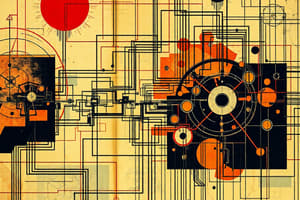Podcast
Questions and Answers
Kirchhoff's Current Law is important in analyzing __________.
Kirchhoff's Current Law is important in analyzing __________.
- 化学反应
- 汽车流量
- 电路网络 (correct)
- 建筑物结构
如果一个电路中进入的电流总数小于离开的电流总数,会发生什么?
如果一个电路中进入的电流总数小于离开的电流总数,会发生什么?
- 电路将会发生短路
- 出现问题 (correct)
- 正常运行
- 电路将会过载
如何使用基尔霍夫电流定律来确定电网的哪个分支为建筑物提供能量?
如何使用基尔霍夫电流定律来确定电网的哪个分支为建筑物提供能量?
- 估算电压
- 测量电阻
- 追踪电流的路径 (correct)
- 计算总电流
在一个电路中,如果一个电池提供1A的电流,然后分成两个分支A和B,用R1和R2分别表示,我们想要找到每个电阻器的电压,应该如何计算?
在一个电路中,如果一个电池提供1A的电流,然后分成两个分支A和B,用R1和R2分别表示,我们想要找到每个电阻器的电压,应该如何计算?
基尔霍夫电流定律对于预测哪些系统行为至关重要?
基尔霍夫电流定律对于预测哪些系统行为至关重要?
何时需要使用代数或高级数学技巧来解决基尔霍夫电流定律相关的方程?
何时需要使用代数或高级数学技巧来解决基尔霍夫电流定律相关的方程?
Kirchhoff's Current Law (KCL) states that the total sum of all current flowing towards any point in a network must equal...
Kirchhoff's Current Law (KCL) states that the total sum of all current flowing towards any point in a network must equal...
根据Kirchhoff's Current Law(KCL),如果您坐在家庭电路系统的某个节点,并计算进入和离开该节点的电子数,它们应该...
根据Kirchhoff's Current Law(KCL),如果您坐在家庭电路系统的某个节点,并计算进入和离开该节点的电子数,它们应该...
Kirchhoff's Current Law(KCL)是否适用于电荷运输中的哪些粒子?
Kirchhoff's Current Law(KCL)是否适用于电荷运输中的哪些粒子?
柯西赫夫电流定律(KCL)指出,在稳态条件下,节点的总输入电流...
柯西赫夫电流定律(KCL)指出,在稳态条件下,节点的总输入电流...
根据柯西赫夫电流定律(KCL),在网络中,向某一点流入的所有电流必须等于...
根据柯西赫夫电流定律(KCL),在网络中,向某一点流入的所有电流必须等于...
为什么柯西赫夫电流定律(KCL)对于携带电荷的粒子是必要的?
为什么柯西赫夫电流定律(KCL)对于携带电荷的粒子是必要的?
Study Notes
Circuit Analysis: Understanding Kirchhoff’s Current Law
Kirchhoff's laws are fundamental principles of circuit analysis used to describe how electrical charge moves through a network of conductors connected by wires. These laws help us understand how electricity flows within circuits, enabling us to calculate voltages, currents, and resistances with accuracy. Here we will explore one of these essential laws—Kirchhoff's Current Law (KCL).
What is Kirchhoff's Current Law?
Named after Gustav Robert Kirchhoff, a German physicist who first proposed it in the late 19th century, KCL states that the total sum of all current flowing towards any point in a network must equal the sum of all current flowing away from that point. This means that if you were to sit at some junction of your home electric system and count the number of electrons going into your house vs those leaving, they would have to balance out. In simpler terms, the net current entering a node should always be zero in a closed loop. This concept might seem counterintuitive because objects may move freely without collisions when moving in different directions; however, this isn't true for charges such as electrons that carry current. Charges cannot split themselves when traveling forward and backward simultaneously. Hence, there can never be more input current than output in steady state conditions.
Let me explain further by using a simple analogy. Imagine a road intersection where cars enter and exit on separate roads leading to other intersections or exits. Now imagine counting each time a car enters and leaves this particular intersection over a certain period. If during that time, the total number of cars arriving was less than the total number of cars departing, something would be amiss! Similarly, in circuits, KCL ensures that the 'car traffic' (current) follows our rules of physics—what goes in must come out.
Why does Kirchhoff's Current Law matter?
Understanding KCL helps us analyze complex networks like electronic circuitry. It provides a systematic approach to solving problems involving multiple components interacting together through various paths. For instance, suppose you're trying to determine which branch of a power grid supplies energy to your building. Using KCL, you could trace back and identify the source by following current flow patterns based on this law.
Applying Kirchhoff's Current Law
When applying KCL, we typically set up equations representing known values and unknown variables related to current. We can then solve them using algebra or if needed, advanced mathematical techniques. Let's say we know that a battery provides 1A of current in one part of a circuit which splits into two branches - A and B. Assuming both branches contain resistors R1 and R2 respectively, we want to find the voltage across each resistor. To do so, we apply Ohm's Law ((V=I\times R)) to every branch and use KCL along with conservation of energy principle to arrive at final expressions for V_A and V_B.
In conclusion, understanding Kirchhoff's Current Law is crucial for accurate prediction of behavior in real world systems involving electric currents. By accounting for the law's principles while drawing diagrams or analyzing physical phenomena, engineers ensure safe operation even under extreme conditions such as high temperatures or sudden changes in load capacities.
Studying That Suits You
Use AI to generate personalized quizzes and flashcards to suit your learning preferences.
Description
Explore the fundamental principle of Kirchhoff's Current Law, which states that the total current flowing towards any point in a network equals the total current flowing away from that point. Learn how to apply this law in circuit analysis to calculate voltages and currents accurately. Understanding Kirchhoff's Current Law is essential for analyzing complex electrical networks and predicting behaviors in real-world systems.




